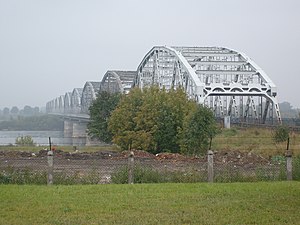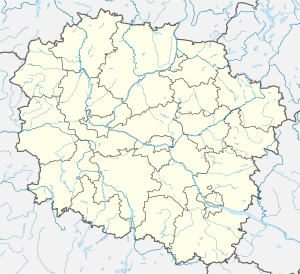Vistula bridge Grudziądz
Coordinates: 53 ° 29 ′ 3 ″ N , 18 ° 44 ′ 21 ″ E
| Vistula bridge Grudziądz | ||
|---|---|---|
| Official name | Bronislaw Malinowski Bridge | |
| Crossing of | Vistula | |
| place | Grudziądz | |
| construction | Truss bridge | |
| overall length | 1098 m | |
| Number of openings | 11 | |
| Longest span | 97 m | |
| Clear width | 94 m | |
| start of building | 1876/1947 | |
| completion | 1879/1951 | |
| location | ||
|
|
||
The Vistula Bridge Grudziądz , officially the Bronisław-Malinowski Bridge , is a combined road and rail bridge near the town of Grudziądz in the Polish Kuyavian-Pomeranian Voivodeship . It leads the national road 16 and the line 208 of the Polish State Railways (PKP) from Laskowice Pomorskie to Grudziądz ( railway line Działdowo – Chojnice ) over the Vistula .
It is named after Bronisław Malinowski , who won the gold medal in the 3000 m obstacle course at the 1980 Summer Olympics in Moscow , but was killed in a car accident on the bridge the following year.
Railway bridge near Graudenz (1879)
The railway bridge near Graudenz in what was then West Prussia , built between 1876 and 1879, was the third railway bridge over the Vistula after the Dirschau bridge, completed in 1857, and the Thorn railway bridge (1873) . In order to avoid ice jams , they were not planned at the narrowest point of the river immediately next to the small town, but further south, where the same flow profile could be created between the dikes that were further apart even after the piers had been installed.
The 1092 m long bridge was built with minor deviations according to the plans for the railway bridge near Thorn. It had 11 openings with a clear width of 94.29 m and 5.5 m thick pillars, which were bridged by Schwedler girders with spans of 97.29 m. As in Thorn, the bridge, which was just over 12 m wide, was divided into 5.0 m for a track , which was separated from the 6.5 m wide lane for the carriages and wagons by a grid. Pedestrian walkways were installed on both sides. The lower edge of the iron structure was more than 2 m above the flood of 1855, the highest recorded water level.
The bridge had no portals or other architectural decorations, but at the request of the military two small log houses with loopholes and a gate to close the bridge were arranged at its western end . At the eastern end there were houses for the bridge staff, who also had to operate the two cranes for lifting and lowering the masts.
During World War II , the bridge was blown up by the Polish army in 1939 to stop the German invasion . It was rebuilt, but destroyed again in 1945 during the fight of the Wehrmacht against the Red Army .
Bronisław Malinowski Bridge (1951)
The bridge was rebuilt between 1947 and 1951. The pillars could still be used, which is why the current bridge again has 11 openings with clear widths of 94.29 m. As a superstructure, steel truss structures with a curved upper flange were built according to plans by Franciszek Szelągowski . As before, the now approx. 16.50 m wide bridge has a railroad track separated by a grid and two lanes for vehicles.
Web links
- The railway bridge over the Vistula near Graudenz. In: Zeitschrift für Bauwesen , year 32, 1882, column 243-272 and column 403-416 as well as sheet 31-42, plan drawings in the atlas for the magazine for building industry , year 32, 1882

